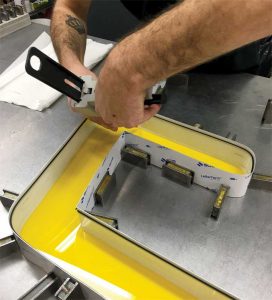
Material considerations are imperative when selecting an adhesive, as not all products are created equal.
What causes read-through?
Adhesives known to cause read-through are prone to a variety of issues, including shrinkage, high curing temperatures, and inadequate flexibility and environmental resistance.
Shrinkage
Adhesives can shrink as they cure. When they do, there is a pull on the substrate, which creates stress at the bond line and may cause it to deform. This is particularly true for adhesives that have high filler content or are formulated with solvents.
High curing temperatures
Some adhesives require high curing temperatures to achieve optimal bond strength. However, if the curing temperature is too high, it can cause the substrate to deform or warp. This is especially true for thin substrates, which are more sensitive to temperature changes.
Inadequate flexibility
Adhesives that are too rigid or have a high modulus are often unable to accommodate the thermal expansion and contraction of the substrate. This can create stress at the bond line and cause the substrate to deform or warp.
Inadequate environmental resistance
Adhesives that are not formulated to withstand environmental factors, such as ultraviolet (UV) exposure or moisture, can degrade or lose bond strength over time, leading to deformation of the substrate.
What causes adhesive cracking?
Adhesive cracking can also occur for several reasons, including stress, changes in temperature, and incompatible combinations of adhesives and substrates.
Excessive stress
If the substrate experiences excessive stress due to bending or twisting, it can cause the adhesive bond to fail.
Temperature changes
Dramatic changes in temperature can cause substrates—such as plastic sheets or aluminum composites—and their adhesives to expand and contract at different rates. This adds additional stress on the bond line, potentially causing the bond to fail.
Incompatible combinations
If the adhesive and substrate are not well-matched in terms of their thermomechanical properties, this can lead to bond failure.
The role of the environment
While signmakers cannot control the weather, they can control their choice of adhesives. The environment is another element that has a direct impact on adhesive cracking. Below are the top five harmful environmental factors known to cause this issue.
- Temperature changes: Rapid or extreme changes in temperature can cause the adhesive to expand or contract at a different rate than the substrate, creating stress, which can lead to cracking.
- UV exposure: Exposure to UV radiation from sunlight or other sources can cause the adhesive to degrade and lose its bond strength, which can eventually lead to cracking.
- Moisture: Exposure to moisture can cause the adhesive to swell or soften, which can lead to cracking under stress.
- Chemical exposure: Exposure to certain chemicals can cause the adhesive to break down or lose its bond strength, which can lead to cracking.
- Mechanical stress: Excessive mechanical stress on the bond, such as from impact or bending, can cause cracking in the adhesive.






